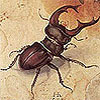|
(En) Painter; Draftsman (b. about 1530 Nuremberg, Germany, d. about 1591 Prague, Czech Republic)
Hans Hoffmann was a leading painter of Nuremberg who was
commissioned by Emperor Rudolf II of Prague to paint Lot 91, "A Hare in a Forest,'
a 62-by-78-inch oil on panel, that is based on Albrecht Durer's "A Study of a
Hare" and "Large Piece of Turf," both in the Albertina in Vienna. Hoffmann added
botanical elements, some exotic, such as the African marigold, and his painting
contrasts sharply with Durer's painting of a hare because his animal is placed
in a natural habitat whereas Durer's was isolated. The picture later became the
property of Queen Christina of Sweden when her country conquered Prague in 1648.
The top of the painting has warped backwards considerable. It has an estimate of
$1,000,000 to $1,500,000. It sold for $2,645,750 to the J. Paul Getty Museum.
Christopher Apostle, senior vice president and director of Sotheby's Old Master
Paintings Department, said after the sale that "we are thrilled that the
Hoffmann painting was purchased by such a distinguished institution. This is a
very unique work, the only known painting by the artist, and commissioned by
Emperor Rudolph II Hapsburg, King of Hungary and Bohemia in 1585."
When veneration of the late Albrecht Dürer's art led to a flurry
of activity copying his paintings, drawings, and prints in the late 1500s, Hans
Hoffmann was the leading representative of the "Dürer Renaissance." Hoffmann's
imitations were so admired that a biographer described him as "a diligent
painter . . . who copied Albrecht Dürer so assiduously that many of his works
were sold as Dürer originals."Little is known of Hoffmann's training. He
probably visited the Netherlands before settling in Nuremberg, where he is first
mentioned in 1576. He specialized in watercolor and bodycolor nature studies,
many copied after or inspired by Dürer's works in a Nuremberg private collection.
Hoffmann's nature studies have earned him consideration as one of Germany's
first still-life painters. He often made several copies and different versions
of a single drawing, signing one with his own monogram and another with Dürer's.
In 1584 he moved to Munich to work for Duke William V of Bavaria. In 1585
Emperor Rudolf II named him court painter and he moved to Prague, the seat of
the imperial court. His oil paintings, of which few survive, seem to have
comprised primarily religious subjects and portraits.
In the late 1400s, northern European artists began to study and draw plants and
animals with a greater interest in accuracy. Although showing the uniqueness of
each of these specimens was undoubtedly important to Hans Hoffmann, he equally
tried to portray the individual beauty of each flower and insect. He placed the
peony, two species of irises, an amaryllis, a may beetle, and a june bug in an
attractive arrangement on the page. He drew the delicate forms carefully and
added lush color in a palette of green, blue, and red. He used plain black chalk
to represent the shadow cast by the beetle's body, illusionistically raising the
beetle's legs off the ground with this trompe-l'oeil effect. Hoffmann may have
intended this arrangement of nature studies to be hung as a painting, since it
was listed as such in the archives of its original owner and it remained in a
frame until well into the 1800s. Scholars consider this one of the first
examples of still life painting.
Hoffmann was a great admirer and imitator of Albrect Durer (who
died before Hoffmann was born) and his paintings were often mistaken for Durer's
(partly because Hoffmann sometimes signed Durer's name to his own work).
(Ru) Немецкий график и живописец, ведущий представитель круга художников, которые были последователями и продолжателями
традиций Альбрехта Дюрера (посмотрите еще раз на знаменитого дюреровского
"Жука-оленя"!).
Хоффман настолько усердно копировал своего кумира, что многие его работы были проданы как оригиналы Дюрера. Мастерство Хоффмана особенно проявлялось в
изображениях растений и животных, и это снискало ему славу одного из первых мастеров натюрморта в Германии.
(De) Deutscher Maler (geboren 1545/1550 in Nürnberg, gestorben 1591/1592 in Prag) |
